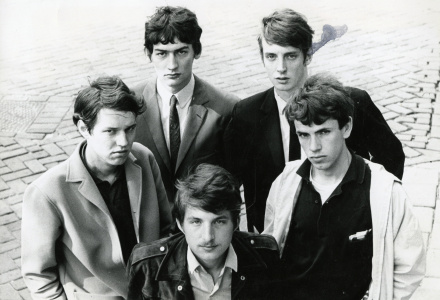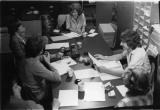Dutch Film Academy
The Dutch Film Academy was established in 1958. Its goal was to educate students in the broadest sense of the word, from directors to studio secretaries. In its first few months, the academy offered only two subjects: ‘Film trade’ and ‘screenplay writing and script technique’. The academy’s temporary housing in the Nieuwe Doelenstraat in Amsterdam consisted of one classroom and one projection room. The first director was Jean Marie Peters, the editor of the Catholic film magazine Filmforum and the Netherlands’ first lecturer of in film studies at the University of Amsterdam.
Joint Venture
The Film Academy was a joint initiative of the Nederlands Filminstituut and the Nederlandse Bioscoopbond (NBB). The Nederlands Filminstituut had been organising ‘courses’ where students were taught the basics principles of ‘artistic filmmaking and film aesthetics’ in a rather rhetorical tone. From the NBB’s perspective, in order to have a thriving film culture, a vigorous feature film industry was needed. The NBB had already been successful in this area with the foundation of the Productiefonds, a production fund for feature films.
Skeptical Reception
This initiative of the Filminstituut and the NBB was received with skepticism. The criticasters brought up the fact that, during the war, Dutch film industry had delivered very few good feature films. In the meantime, Dutch audiences were gaping in admiration at American and German productions and didn’t seem to see the lack homegrown feature films as a great loss. Why start up an academy for feature films, if no one was interested? Why not offer courses in documentary making, or commissioning films, or commercials? The Netherlands had built up a sturdy international reputation in those areas over the years. And what about that new and promising medium, television? And to cap it all, the Nederlandse Beroepsvereniging van Filmers published a critical article in its bulletin entitled, ‘Vocational training or vocational deception?’ in which it let it be known that it was concerned for the students who, in their naiveté, ‘were made to think that they were being trained for a vocation’.
A Creative Crop
Despite all the criticism and doubts, the academy was still started up. In the first year, 43 students were registered, including Frans Weisz, the first student. As predicted by the Beroepsvereniging van Filmers, the first crop of graduates had to find their way a society where there was no relevant infrastructure available. What the professional association hadn’t foreseen, however, was that the new directors and producers would make an enterprising and creative leap forward and sought their own way in a more individual and libertine society. The best-known examples of this were Wim Verstappen and Pim de la Parra who, after graduating, created their own little universe within the film world that was at odds with existing production structures.
The Academy in Recent Years
Over 50 years later, the academy is now housed in a modern complex with two large studios, several editing and mixing rooms, a viewing room and all the modern facilities possible. Its name has since been changed to the Nederlands Film en Televisie Academie. Around 2,200 students have graduated from the academy since its founding, including Lodewijk Crijns, Pieter Verhoeff, Dick Maas, Martin Koolhoven, David Lammers, Robby Müller, Jan de Bont, Frans Bromet, and Dana Nechushtan. One student, Ian Kerkhoff, surprised everyone in 1992 by winning a Golden Calf for best film with his student project called Kyodai Makes the Big Time. Another student, Mike van Diem, won a Student Academy Award in 1990 for his final examination film, Alaska. The academy also has some well-known graduates: Paul Verhoeven, Jean van de Velde, René Segers and Leon de Winter.
more information
If you are looking for more material from our collection, please contact Film Sales:
sales@eyefilm.nl
phone +31 (0)20 5891 426


